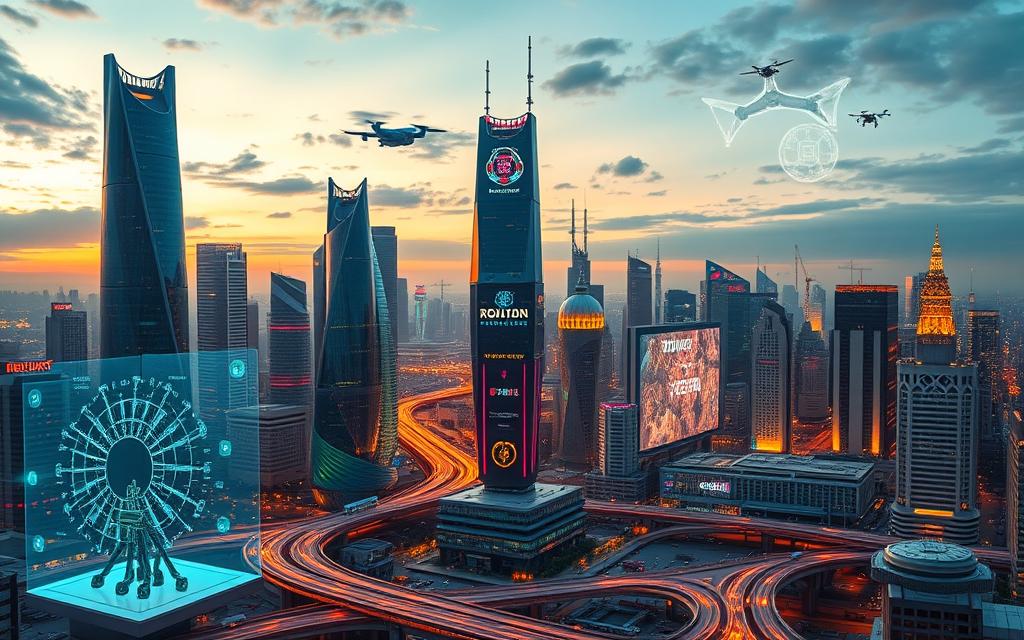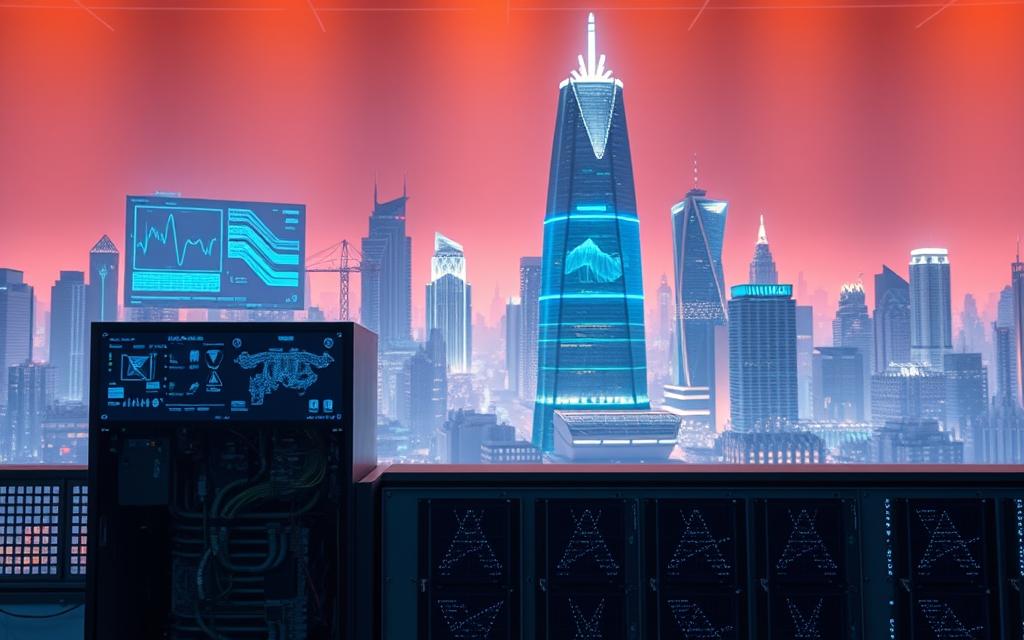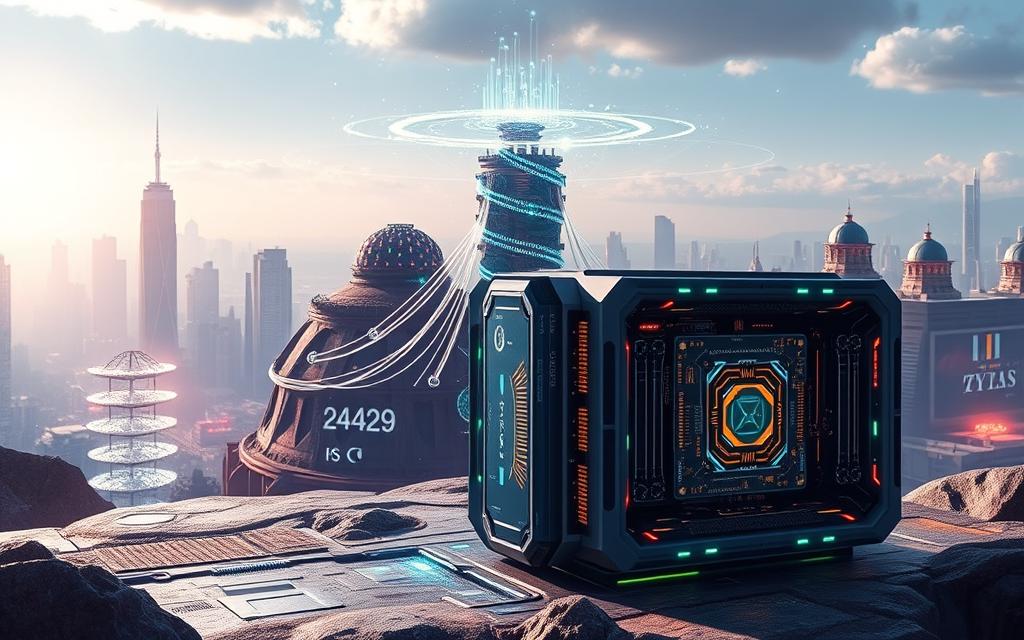The 21st century has seen technology advance faster than ever before. Gartner’s latest report shows 74% of organisations are now focusing on advanced systems. These systems combine physical and digital parts, bringing both new chances and big challenges to all areas.
Quantum computing could change drug discovery for the better. AI is helping plan cities of the future. In healthcare, AI makes diagnoses more accurate. Banks use blockchain for unprecedented security in transactions.
Experts are under pressure to use these new technologies wisely. They must also think about ethics and how to train workers. The next ten years will be all about understanding how these technologies change the way we work, what customers expect, and how we compete globally.
This article looks at how new tech is changing three key areas: medical research, the economy, and smart cities. It offers useful tips for businesses ready to embrace big changes in technology.
The Transformative Power of Emerging Technologies
Today, innovation moves faster than we can keep up, bringing both chances and hurdles. This speed leads to industry disruption on a massive scale. Gartner says 58% of companies now face quicker decision-making times than before the pandemic.
Defining technological evolution in the 21st century
Acceleration of innovation cycles
Before, making new medicines took a decade. But mRNA vaccines got approval in just under 11 months. Cisco’s 2024 IoT report shows 73% of tech leaders think old 5-year plans are outdated. Three main reasons drive this change:
- Cloud computing makes quick prototyping possible
- Open-source models boost collaboration
- AI tools speed up simulations
Convergence between digital and physical worlds
Singapore’s Smart Nation project is a great example of tech convergence. It combines 5G networks with city infrastructure. Microsoft’s 2024 Work Index reveals 68% of manufacturing firms use digital twins for real-world operations. An industry expert notes:
“The lines between software updates and hardware upgrades have vanished – your car improves through WiFi while parked in your driveway.”
Global impact across industries
Healthcare transformation
AI can now spot early cancer with 94% accuracy, according to Lancet Digital Health. This change goes beyond just new tools:
| Traditional Approach | Emerging Tech Solution | Impact |
|---|---|---|
| Manual drug discovery | Quantum computing simulations | 62% faster development |
| Paper-based records | Blockchain patient databases | 100% audit transparency |
Financial systems overhaul
Blockchain now handles $14 trillion a year, cutting transaction times from days to minutes. JPMorgan’s Coin Systems show how digital transformation changes old banking:
- Instant cross-border payments
- Smart contract automation
- Fraud detection AI with 99.8% accuracy
What Are Some Examples of Emerging Technology?
Emerging technologies are different from small improvements. They change how industries work and solve big global problems.

Core characteristics of emerging tech
Disruptive potentials
CRISPR-Cas9 is a great example in biotech. It lets us make exact DNA changes. This changes how we treat genetic diseases, not just manage symptoms.
Scalability needs
Tesla’s Megapack shows how scalable technologies meet big energy needs. Each Megapack can power 3,600 homes for an hour. Its design makes it easy to grow, helping cities and remote areas.
Key adoption drivers
Market demands
IBM Quantum Experience is a hit with businesses. Over 500 companies use its quantum systems for tough simulations. Experts think quantum AI will get £12.7 billion in investments by 2026.
Environmental pressures
Climeworks’ carbon capture plants are a big step towards green tech. Their Icelandic plant takes 4,000 tonnes of CO₂ out of the air each year. Edge computing also helps by cutting down on energy use in data centres.
These examples show a key point: good emerging tech meets big goals with real solutions. Whether it’s fast problem-solving with quantum computing or health breakthroughs in biotech, they tackle today’s big challenges.
Artificial Intelligence: Beyond Machine Learning
Artificial intelligence has grown a lot from old machine learning. New things like neural networks and generative AI are changing what machines can do. These new ideas are making big changes in many areas, like health and cars.
AI systems can now think like humans and work on a huge scale. They make decisions fast and understand data in new ways.
Deep Learning Advancements
Today’s deep learning uses new types of networks. For example, Tesla’s Autopilot uses special networks to see the road. This helps it make quick decisions.
Neural Network Architectures
New ideas like attention mechanisms help AI focus on what’s important. Models like GPT-4 can understand patterns in a detailed way. This is thanks to their huge number of parameters.
Microsoft has seen a big increase in jobs for these AI experts. This shows how important they are in the business world.
Real-Time Decision Systems
AI is now used for quick analysis in many fields. It helps spot fraud and makes robots work better. Research has made AI faster and more reliable.
Natural Language Processing Breakthroughs
Large language models like Gemini and GPT-4 are changing how we talk to machines. They understand text and can even create new content. For more on this, check out these 10 examples of artificial intelligence changing how we communicate.
Large Language Models (GPT-4, Gemini)
GPT-4 can translate languages very well. Gemini can turn speech into 3D images. But there are also worries about the ethics of creating fake content.
Conversational AI Implementations
Businesses use chatbots to help customers. These chatbots can solve most problems on their own. They even understand when someone is upset.
Practical Applications
AI is making a big difference in many areas. In hospitals, it helps find the best treatments. On the roads, it helps cars drive better.
IBM Watson in Healthcare Diagnostics
IBM Watson looks at many things to find the best treatment. It’s very good at spotting problems that humans might miss. It’s also getting better at finding the right treatment for cancer.
Tesla Autopilot Systems
Tesla’s Autopilot uses many neural networks to drive. It can change lanes and avoid obstacles. It learns from millions of cars to get better.
Quantum Computing: The Next Frontier
Quantum computers use qubits for fast calculations. They apply quantum mechanics to solve problems that old computers can’t. This is a big change in how we do computing.

Fundamental Principles
Quantum computing is based on qubit superiority over classical bits. Unlike binary bits, qubits can be in many states at once. This lets them process lots of information at the same time.
Quantum Entanglement Applications
Entangled qubits can share information instantly, no matter the distance. This helps in making secure communication and very accurate sensors.
Leading Developments
Big tech companies are working hard to show quantum advantage. They want to prove that quantum computers are better than old ones. There are two big achievements:
IBM Quantum Experience
IBM has a 433-qubit processor called Osprey. It focuses on making quantum computing more reliable. IBM lets researchers from all over try out quantum algorithms online.
Google Sycamore Processor
Google’s 53-qubit Sycamore processor solved a problem in 200 seconds. They say old computers would take 10,000 years. This achievement started a debate about what really shows quantum computers are better.
Commercial Implementations
Quantum computing is already helping businesses in many ways:
Cryptography Advancements
Shor’s algorithm can break current encryption fast. To keep data safe, post-quantum cryptography is being made. NIST is working on standards to protect our digital world.
Pharmaceutical Modelling
Moderna uses quantum computers to make mRNA vaccines faster. This method could cut down the time it takes to find new drugs by years.
IQM thinks that by 2030, we’ll see more use of quantum computers. They will work with old computers to bring us the full quantum advantage in certain areas.
Biotechnology Innovations Reshaping Medicine
Modern biotechnology is changing healthcare with new tools that mix biology and engineering. It’s about rewriting genes and making real human tissues. These steps focus on precision medicine and solving diseases that were once thought impossible.
Gene Editing Revolution
CRISPR-Cas9 Applications
CRISPR-Cas9 is better than old methods, with 80-90% gene knock-in efficiency compared to 10-20% for ZFNs. It’s used to fix sickle cell anaemia and make crops that can handle drought. Early trials show it can treat genetic diseases faster.
mRNA Vaccine Technology
BioNTech’s COVID-19 vaccine was tested in humans in just 42 days, showing 95% success. Moderna is using this tech for personalised cancer vaccines. They’re focusing on melanoma, targeting specific tumour proteins.
| Editing Tool | Efficiency | Primary Use | Development Time |
|---|---|---|---|
| CRISPR-Cas9 | 85% | Gene therapy | 2012-present |
| ZFNs | 15% | Targeted mutagenesis | 1996-2010 |
Bioengineering Milestones
3D-Printed Organs
Organovo has made liver tissues that work like real ones, with 90% functional equivalence. This bioprinting could solve organ shortages in the next decade.
Synthetic Biology Advances
Ginkgo Bioworks can design microbes to make rare medicines. Their synthetic genomics has made a malaria treatment 40% cheaper than before.
Internet of Things and Smart Infrastructure
Today, devices are connected everywhere, shaping urban planning and industry. Over 30 billion IoT devices are expected by 2025. This network lets cities and businesses make decisions quickly with real-time data.
Urban Development Solutions
Cities like Singapore are leading the way with smart city networks. They use IoT sensors to track traffic and energy use. This has cut down on traffic jams by 22% during peak hours.
Barcelona’s IoT Deployment
Barcelona has made its waste management smarter with bin sensors. These sensors have saved the city 35% on costs and boosted recycling.
Industrial Applications
Industrial IoT is changing how factories work. Platforms like Siemens MindSphere and PTC ThingWorx are key. They bring:
- Predictive maintenance systems: ABB Ability spots wind turbine issues 14 days early, avoiding failures
- Supply chain optimisation: Maersk keeps medicines cool with sensors, ensuring they arrive safely
Asset Tracking Breakthroughs
RFID technology gives a clear view of goods in logistics. DHL has sped up deliveries by 28% in Europe with asset tracking.
Blockchain and Decentralised Systems

Blockchain technology is changing how we do business. It uses smart contracts and tokenisation to add value in many areas. At first, people talked a lot about cryptocurrencies. Now, they see how blockchain can solve problems in global trade.
Beyond Digital Currencies
Smart contracts make complex deals easier without needing middlemen. For example, Ethereum’s update helped IBM Food Trust track food from farm to store. This cut down on contamination risks by 35%.
NFT Authentication Uses
- Art provenance verification through permanent ownership records
- Event ticket anti-counterfeiting with unique digital identifiers
- Academic credential validation via tamper-proof certificates
Enterprise Adoption Accelerates
Big companies are using blockchain for their supply chains. Maersk’s TradeLens cut shipping costs by 60% by tracking cargo in real-time at over 300 ports.
De Beers Diamond Tracking
Tracr tracks diamonds from mines to stores to stop conflict diamonds. It checked £4.8 billion worth of diamonds in 2023. This shows how blockchain can solve big problems.
| Platform | Industry | Key Benefit |
|---|---|---|
| Hyperledger Fabric | Healthcare | Patient data security |
| Ethereum Enterprise | Retail | Loyalty tokenisation |
| Walmart Traceability | Food Safety | Recall speed improvement |
Augmented Reality and Spatial Computing
Augmented reality (AR) and spatial computing are set to grow into a $1.5 trillion market by 2030, says PwC. These technologies add digital info to real-world settings, making mixed reality experiences. They improve decision-making and user interaction.

Industrial Applications of Microsoft HoloLens
Manufacturing Visualisation
BMW uses HoloLens 2 to show 3D assembly guides on car parts. This cuts down errors by 32% in tests. The device’s wide field of view beats Magic Leap 2, making complex tasks clearer.
Surgical Training Applications
At Johns Hopkins Hospital, surgeons use HoloLens for spinal surgeries. They see CT scans superimposed on patients with 0.5mm accuracy. This shortens surgery times by 25%.
Consumer Market Evolution
Apple Vision Pro Capabilities
Apple’s spatial computer has 23 million pixels per eye for realistic visuals. Early users see 40% quicker design approvals with IKEA Place’s accurate furniture tool.
Meta Quest 3 Innovations
Meta’s new headset has 4K resolution and hand-tracking for 87 gestures. Lowe’s sees 28% fewer returns with virtual room previews.
| Feature | HoloLens 2 | Magic Leap 2 |
|---|---|---|
| Field of View | 52° | 44° |
| Weight | 566g | 260g |
| Industrial Use Cases | BMW, Stryker | NASA, Siemens |
Clean Energy and Sustainable Tech

The push for net-zero emissions has made sustainable tech key for decarbonisation. These innovations help store renewable energy and clean the atmosphere. They change how industries see their role in protecting the environment.
Renewable Energy Storage
Tesla Megapack installations have added 3.9M kWh of grid-scale storage worldwide. This helps keep power steady for solar and wind-based systems. Companies like Ørsted are using this tech to turn extra energy into clean fuel.
Hydrogen Fuel Cell Advances
PEM fuel cells are used in cars because they start up quickly. Alkaline fuel cells are better for big decarbonisation projects. Both are now over 60% efficient, making green hydrogen a real option.
Carbon Capture Technologies
Climeworks in Switzerland has 18 direct air capture plants. They remove 4,000 tonnes of CO₂ every year. Carbfix in Iceland uses a special method to lock carbon in rock for good in just two years.
Enhanced Mineralisation Techniques
This method speeds up how CO₂ reacts with rock. The US Department of Energy is investing $3.5 billion in DAC tech. They aim to make it big in North America by 2030.
“Carbon removal isn’t optional anymore – it’s a prerequisite for climate stability.”
Conclusion
Quantum computing and artificial intelligence are changing the tech world. IBM and Google are leading the way with their work. They’re making big steps in finding new medicines and understanding the climate.
Companies that use these new technologies are getting ahead. They’re using data to make better decisions. This is a big advantage in today’s fast-paced markets.
It’s important for workers to learn about AI. The World Economic Forum says 71% of employers want people with AI skills. Tools like Microsoft’s GitHub Copilot and DeepMind’s AlphaFold are changing jobs.
People need to keep learning to stay up-to-date. Sites like Coursera and Udacity can help with that. They teach important skills for the future.
There’s a big need for rules in new tech areas. The European Commission and Intel are working on this. They want to make sure new tech is used responsibly.
Companies that use green tech are doing well. They’re not just making money; they’re also helping the planet. This is a smart move for the future.
To do well in the future, we need to keep learning and work together. Places like Boston and Singapore are showing us the way. They’re combining tech with ethics to make a difference.
The next ten years will be exciting. Those who adapt and work together will succeed. It’s a time of big change, and we’re all part of it.







